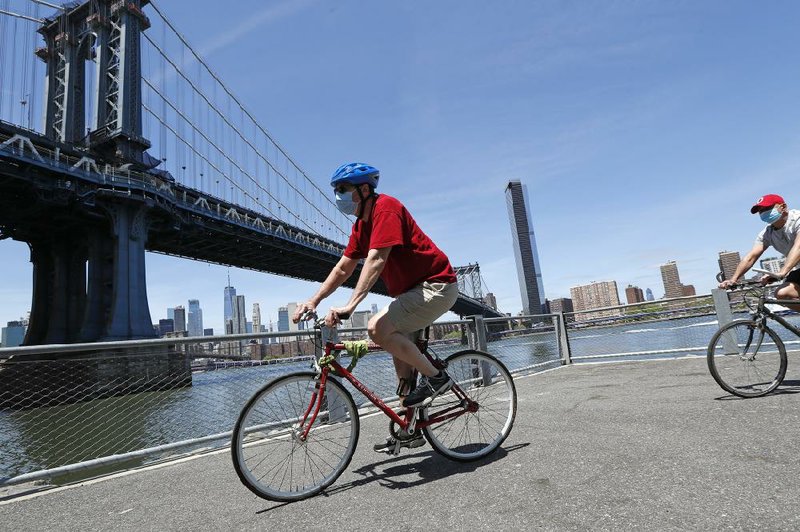Some bicycle shops in Brooklyn are selling twice as many bikes as usual and drawing block-long lines of customers. A chain of shops in Phoenix is selling three times the number of bikes that it typically does. A retailer in Washington, D.C., sold all its entry-level bikes by the end of April and has fielded more preorders than ever in its 50-year history.
As the coronavirus pandemic shrinks life in large U.S. cities -- limiting pastimes and discouraging use of buses and subways -- many Americans are flocking to one of the most basic forms of mobility: the bicycle.
In March, nationwide sales of bicycles, equipment and repair services nearly doubled compared with the same period last year, according to the NPD Group, a market research company. Sales of commuter and fitness bikes in the same month increased 66%, leisure bikes jumped 121%, children's bikes went up 59% and electric bikes rose 85%.
By the end of April, many stores and distributors had sold out of low-end consumer bikes. Now, the United States is facing a bicycle shortage as global supply chains, disrupted by the coronavirus outbreak, scramble to meet the surge in demand.
"I have never seen anything remotely approaching this," said Ryan Zagata, president of Brooklyn Bicycle Co., where sales have soared by more than 600% this year compared with the same period in 2019. "If you went into a store three weeks ago you could find a bike under $1,000. Right now shelves are bare."
The spike in sales comes on the heels of stay-at-home orders that have temporarily curtailed daily life.
Some U.S. cities are already planning for a lasting shift after the pandemic -- a significant departure in a society that has favored cars over bikes for decades, even as European cities embraced cycling as a transportation mode as integral as New York City's subway.
"We are absolutely confident we are going to see more bike commuting in the months ahead," said Polly Trottenberg, New York City's transportation commissioner.
In April, New York announced that it would temporarily open 100 miles of roads to pedestrians and cyclists -- a move that may lead to permanent closures, officials say. Oakland, Calif., has shut down about 10% of its streets to cars during the pandemic, while Seattle said it would permanently close 20 miles of roads.
"We are already seeing people who hadn't biked before are trying it for the first time," Trottenberg said. "We are going to see a lot more of that as the city starts to come back to life."
CARS TO BIKES
The change would be a notable departure from the role bikes have tended to play in American life. For generations, riding a bike has been a symbol of relaxed summer days and a nostalgic rite-of-passage for children growing up in suburban sprawl.
More recently, road biking became a popular hobby in warm-weather cities on the West Coast, while on the other side of the country, hipsters adopted bikes as part of their against-the-grain brand of cool.
Still, relatively few Americans have used bikes as a serious alternative to cars and public transit. Today fewer than 1% of New Yorkers commute by bike. In Portland, Ore., which has the highest percentage of cycling commuters of any American city, only 6.3% of commuters ride bikes. By comparison, in Copenhagen nearly half of all trips to work and school take place on bicycles.
[CORONAVIRUS: Click here for our complete coverage » arkansasonline.com/coronavirus]
"The U.S. has been built around cars," said Sarah M. Kaufman, associate director of New York University's Rudin Center for Transportation Policy and Management. "The European model has tended to be more forward looking in terms of sustainability and safety, which leads them to favor bikes."
But since the pandemic upended daily life in the United States, cycling has taken on a crucial role: bikes are a way to exercise while gyms stay closed and an inexpensive means of getting around cities where more than 90% of riders have abandoned public transportation.
At first, most customers were buying bikes under $1,000, industry leaders and shop owners say. By the end of April, many stores had sold out of those bikes.
"We've never seen a surge like this across a range of products," said Robert Margevicius, executive vice president of Specialized, one of the largest bicycle companies in the United States. "Everybody is scrambling to get more."
IMPORTS HIT BRAKES
But the demand could not have not come at a worse time.
Most American importers have kept limited inventory since 2018, when President Donald Trump ordered new tariffs on goods produced in China, which makes some parts used on nearly all bikes sold in the U.S.
As a result, in 2019 the number of bikes imported into the United States dropped by around 25% compared with 2018, according to Margevicius. In the first quarter of this year, imports were down by around 30% compared to the same period in 2019.
The pandemic also forced factories in Asia to shut down in January and February, stalling the production of new bikes. Many were not able to bring production back to capacity until April, even as requests from importers swelled.
Most American importers expect the first shipments of new bicycles to arrive by mid-June, though many retailers have already sold most of the inventory they expect to receive then through early orders from customers.
Some aspiring cyclists may have to wait until July or August for the next shipments of low-end consumer bikes to arrive, retailers say.
"There is no way to keep inventory for sub-$1,000 bikes," said Lee Katz, co-owner of Turin Bikes in Chicago. "We've got a few right now, but it's a matter of scrambling for them. We really don't expect to see much in the way of inventory like that until July."
Business on 05/20/2020
